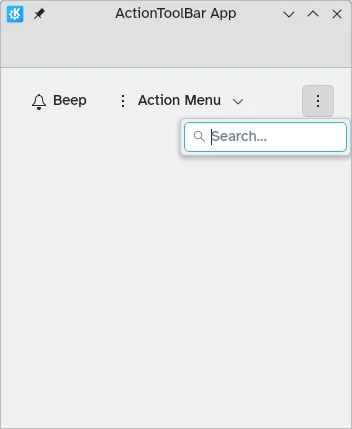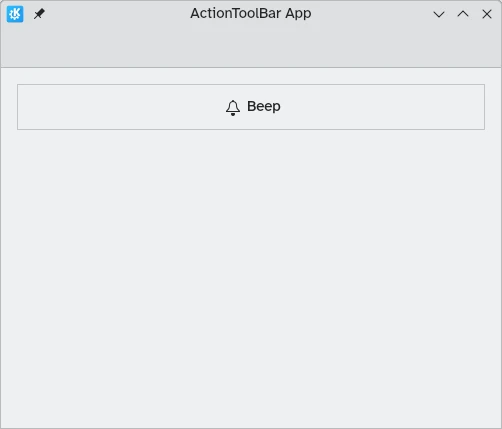Barre degli strumenti delle azioni
Sebbene le pagine di Kirigami ti permettono di disporre con semplicità un insieme di azioni nell'intestazione di una pagina, altre volte potresti volere qualcosa di più flessibile.
Kirigami provides the component Kirigami.ActionToolBar. It displays a list of Kirigami.Action objects and will display as many of them as possible, providing an overflow menu for the ones that don't fit. The ActionToolBar is dynamic and will move actions in and out of the overflow menu depending on the size available to it.
Nota
This page assumes you are familiar with Kirigami.Action objects. If you are not, you can learn all about them in our beginner tutorial or in the dedicated documentation page for them.Creazione della prima ActionToolBbar
The layout and location of your Kirigami.ActionToolBar are really up to you, though for the sake of user-friendliness it is usually a good idea to stick to UI conventions and put your toolbar near the top or bottom of your page and to have it spread width wise.
Like most other action-holding components, Kirigami.ActionToolBar has an actions property. We can assign an array of Kirigami.Action components to this property.
import QtQuick
import QtQuick.Layouts
import QtQuick.Controls as Controls
import org.kde.kirigami as Kirigami
Kirigami.ApplicationWindow {
id: root
title: "ActionToolBar App"
width: 600
height: 400
pageStack.initialPage: Kirigami.Page {
Kirigami.ActionToolBar {
anchors.left: parent.left
anchors.right: parent.right
actions: [
Kirigami.Action {
text: "Beep"
icon.name: "notifications"
onTriggered: showPassiveNotification("BEEP!")
},
Kirigami.Action {
text: "Action Menu"
icon.name: "overflow-menu"
Kirigami.Action {
text: "Deet";
icon.name: "notifications"
onTriggered: showPassiveNotification("DEET!")
}
Kirigami.Action {
text: "Doot";
icon.name: "notifications"
onTriggered: showPassiveNotification("DOOT!")
}
},
Kirigami.Action {
icon.name: "search"
displayComponent: Kirigami.SearchField { }
}
]
}
}
}
Una ActionToolBar con abbastanza spazio per tutti i figli

Una ActionToolBar con il menu a espansione contenente i figli
Allineamento
By default, actions in the Kirigami.ActionToolBar will be left aligned. This might not be desirable in all situations. Thankfully we can change this with the alignment property. We can set this property to a range of values, but the three most relevant ones are Qt.AlignLeft, Qt.AlignCenter, and Qt.AlignRight (which deal with horizontal alignment).
import QtQuick
import QtQuick.Layouts
import QtQuick.Controls as Controls
import org.kde.kirigami as Kirigami
Kirigami.ApplicationWindow {
id: root
title: "ActionToolBar App"
width: 600
height: 400
pageStack.initialPage: Kirigami.Page {
Controls.GroupBox {
anchors.left: parent.left
anchors.right: parent.right
Kirigami.ActionToolBar {
anchors.fill: parent
alignment: Qt.AlignCenter
actions: [
Kirigami.Action {
text: "Beep"
icon.name: "notifications"
onTriggered: showPassiveNotification("BEEP!")
}
]
}
}
}
}